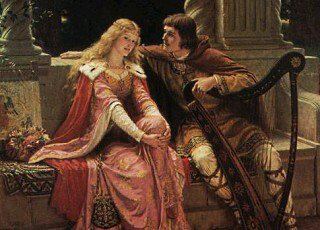Courtly Love
The romance of Courtly Love practised during the Middle Ages was combined with the Code of Chivalry. There were strict rules of courtly love and the art of courtly love was practised by the members of the courts across Europe during the Middle Ages. The romance, rules and art of courtly love allowed knights and ladies to show their admiration regardless of their marital state. It was a common occurrence for a married lady to give a token to a knight of her choice
to be worn during a Medieval tournament. There were rules which governed courtly love but sometimes the parties, who started their relationship with such elements of courtly love, would become deeply involved. A famous example of a relationship which was stirred by romantic courtly love and romance is described in the Legend of King Arthur, where his Queen, Guinevere fell in love with Sir Lancelot. Many illicit court romances were fuelled by the practise and art of courtly love.
The Origins of Courtly Love
The origins of Courtly Love were believed to be in Aquitaine in France in the 12th century and spread to other European countries. The art of courtly love was practised in English courts from the 1300's to the 1500's. During this period of time marriages were arranged and had little to do with love. A successful marriage was perceived as one that brought material advantages to the participants and their families. As love was clearly unrelated to marriage the requirement for romance could be gained outside marriage - as long as the rules relating to chastity and fidelity were strictly adhered to.
The Rules of Courtly Love
The violence and wars of the Middle Ages were tempered by the Rules of Courtly Love. The following rules and elements of Courtly Love during the Middle Ages were written by the 12th Century Frenchman, Andreas Capellanus:
Marriage is no real excuse for not loving
He who is not jealous, cannot love
No one can be bound by a double love
It is well known that love is always increasing or decreasing
That which a lover takes against the will of his beloved has no relish
Boys do not love until they arrive at the age of maturity
When one lover dies, a widowhood of two years is required of the survivor
No one should be deprived of love without the very best of reasons
No one can love unless he is impelled by the persuasion of love
Love is always a stranger in the home of avarice
It is not proper to love any woman whom one would be ashamed to seek to marry
A true lover does not desire to embrace in love anyone except his beloved
When made public love rarely endures
The easy attainment of love makes it of little value; difficulty of attainment makes it prized
Every lover regularly turns pale in the presence of his beloved
When a lover suddenly catches sight of his beloved, his heart palpitates
A new love puts to flight an old one
Good character alone makes any man worthy of love
If love diminishes, it quickly fails and rarely revives
A man in love is always apprehensive
Real jealousy always increases the feeling of love
Jealousy, and therefore love, are increased when one suspects his beloved
He whom the thought of love vexes eats and sleeps very little
Every act of a lover ends in the thought of his beloved
A true lover considers nothing good except what he thinks will please his beloved
Love can deny nothing to love
A lover can never have enough of the solaces of his beloved
A slight presumption causes a lover to suspect his beloved
A man who is vexed by too much passion usually does not love
A true lover is constantly and without intermission possessed by the thought of his beloved
Nothing forbids one woman being loved by two men or one man by two women






 رد مع اقتباس
رد مع اقتباس

